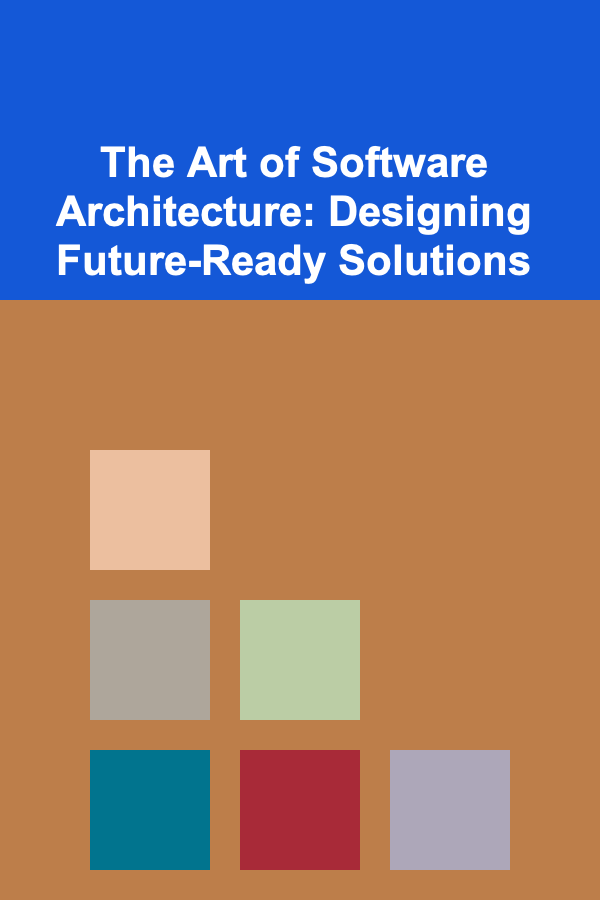
The Art of Software Architecture: Designing Future-Ready Solutions
ebook include PDF & Audio bundle (Micro Guide)
$12.99$5.99
Limited Time Offer! Order within the next:

In the rapidly evolving field of software development, software architecture has emerged as one of the most crucial disciplines. At its core, software architecture is about making strategic decisions that lay the foundation for future-proof systems---systems that not only work effectively today but can also scale and adapt as requirements change over time. Designing a future-ready solution requires vision, technical expertise, and the ability to anticipate future challenges.
This actionable guide explores the principles, patterns, tools, and mindset required to craft software architectures that are not only functional but adaptable, scalable, and sustainable in the long run.
The Vision Behind Future-Ready Software Architecture
Designing future-ready software starts with a long-term vision. While it's easy to focus on immediate project goals---such as solving a current problem or hitting a specific deadline---software architects must keep an eye on how the system will evolve over time. In today's world, the only constant is change. New technologies emerge, business needs evolve, and user demands shift. As a result, software systems must be designed to accommodate this constant change.
Key Considerations for Future-Ready Systems
- Scalability: Systems must be able to grow, whether it's in terms of user traffic, data volume, or functionality. Scalability ensures that the system can handle increasing demand without a complete overhaul.
- Flexibility: Business requirements change, and software needs to be able to adapt. A flexible architecture allows easy modification and extension of the system as needs evolve.
- Maintainability: Software must be easy to maintain and update. Over time, bugs and technical debt will accumulate, so the system should be designed to accommodate these without becoming brittle or difficult to change.
- Resilience: As systems grow more complex, failure is inevitable. A future-ready architecture should include mechanisms for recovery, graceful degradation, and error handling to minimize the impact of failure.
- Security: With increasing concerns about data breaches and security threats, a future-ready system should be designed with security as a first-class citizen, incorporating appropriate measures for authentication, authorization, encryption, and threat detection.
Core Principles for Designing Future-Ready Architectures
Building a future-ready software system begins with an understanding of fundamental architectural principles. These principles are not just technical best practices; they also define how the system will evolve as new challenges arise.
1. Separation of Concerns
Separation of Concerns (SoC) is a design principle that advocates breaking down a system into distinct, independent modules, each responsible for a specific functionality. By isolating concerns, developers can ensure that changes in one part of the system don't cascade into others.
For instance, separating the user interface from business logic or data storage is a common practice that allows teams to modify or update one area without affecting others. This makes the system more modular and adaptable in the long run.
Actionable Tip: When designing a new system, ensure that each module or component has a single responsibility and clear boundaries. This approach promotes easier maintenance and scaling.
2. Modularity and Componentization
Modularity is closely tied to the concept of separation of concerns. By designing software as a collection of loosely coupled, independently deployable modules or services, architects create systems that are more flexible and easier to evolve over time.
This modular approach is at the heart of microservices architecture, where each service encapsulates a single piece of functionality and can be developed, deployed, and scaled independently.
Actionable Tip: When considering new features, break them down into discrete modules. Not only does this enable parallel development, but it also makes it easier to replace or upgrade individual components without affecting the whole system.
3. Design for Scalability
A future-ready system must be capable of scaling to meet growing demands. There are two primary approaches to scaling:
- Vertical Scaling (Scaling Up): This involves adding more resources (CPU, memory) to an existing server. While this approach is simple, it has limitations and can become cost-prohibitive at scale.
- Horizontal Scaling (Scaling Out): This involves adding more servers to distribute the load. Horizontal scaling is more flexible and scalable as it allows the system to grow by adding more resources in parallel.
Actionable Tip: Design systems with horizontal scaling in mind. Consider cloud services (e.g., AWS, Azure, Google Cloud) that offer tools like load balancing, auto-scaling, and distributed storage to automatically adjust resource allocation based on demand.
4. Loose Coupling and High Cohesion
Loose coupling refers to designing components in such a way that they have minimal dependencies on each other. This allows teams to develop, test, and deploy components independently of one another. High cohesion, on the other hand, means that a module or component should only have responsibilities that are closely related to one another.
Together, loose coupling and high cohesion promote flexibility and ease of maintenance, as changes to one component are less likely to impact other components.
Actionable Tip: Strive for low dependency between components. Use interfaces, APIs, or message queues to ensure that components interact through well-defined contracts rather than direct connections.
5. Fail Fast and Graceful Degradation
As systems grow in complexity, it becomes more likely that something will go wrong. A future-ready architecture must account for potential failures and allow for graceful degradation---the system should continue functioning at a reduced capacity if a component fails, rather than crashing entirely.
Additionally, implementing fail-fast mechanisms helps to identify and resolve issues early, before they have a chance to propagate throughout the system.
Actionable Tip: Incorporate circuit breakers, retries, and fallback mechanisms into your system design to allow for resilience in the face of failure. Use logging and monitoring to detect problems early and fix them proactively.
Architectural Patterns for Future-Ready Systems
In addition to adhering to core principles, software architects can use established architectural patterns to guide their design decisions. Here are some of the most important patterns that help design scalable and maintainable systems.
1. Microservices Architecture
Microservices architecture is a popular approach to building future-ready systems. In a microservices architecture, the system is divided into small, self-contained services that communicate over a network. Each service can be developed, deployed, and scaled independently.
Advantages:
- Independent scaling: Services can be scaled independently based on their load.
- Technology diversity: Teams can choose the best technology stack for each service.
- Fault isolation: Failure in one service does not bring down the entire system.
However, microservices come with their own challenges, such as increased complexity in deployment and the need for sophisticated monitoring and management systems.
Actionable Tip: Start by identifying core domain boundaries in your application and then design microservices around those domains. Use tools like Kubernetes and Docker to manage microservice deployments effectively.
2. Event-Driven Architecture (EDA)
In an event-driven architecture, systems communicate by emitting and responding to events. This pattern is well-suited for systems that need to respond to real-time changes, such as e-commerce systems, financial platforms, or IoT applications.
Advantages:
- Loose coupling: Components are decoupled, as they don't need to know the specifics of each other's behavior.
- Real-time response: Events trigger actions in real-time, which is ideal for applications that require immediate responses.
EDA is commonly used in combination with microservices, where each service emits events to communicate changes.
Actionable Tip: Use message brokers like Kafka or RabbitMQ to handle events and ensure that your system can scale and respond to high-throughput event streams.
3. Layered Architecture
Layered architecture divides a system into distinct layers, each responsible for a specific type of processing. Common layers include:
- Presentation Layer: Deals with user interfaces and interaction.
- Business Logic Layer: Handles core business rules and application logic.
- Data Access Layer: Manages interactions with data sources.
Layered architecture is a proven pattern for ensuring maintainability and scalability.
Actionable Tip: For large applications, use layered architecture to promote separation of concerns. Ensure that each layer only interacts with the layer directly beneath it to keep things modular and testable.
Leveraging Modern Tools and Practices
While architectural principles and patterns lay the foundation for future-ready systems, the tools and practices used to implement these designs are equally important. Below are some modern tools and practices that support the creation of scalable, maintainable, and resilient systems.
1. Cloud-Native Architecture
Cloud platforms offer scalability, redundancy, and global reach, making them ideal for future-proof systems. By leveraging cloud-native tools like Kubernetes, Docker, and serverless computing, architects can build systems that are inherently scalable and resilient.
Actionable Tip: Embrace cloud-native development by designing systems that are containerized and can be orchestrated by tools like Kubernetes. Consider using serverless computing for handling unpredictable workloads.
2. CI/CD and DevOps Practices
The practices of Continuous Integration (CI) and Continuous Delivery (CD) are fundamental to building future-ready software. CI/CD automates the process of testing and deploying code, ensuring faster releases and higher software quality. DevOps practices further enhance collaboration between development and operations teams, ensuring that software is delivered reliably and efficiently.
Actionable Tip: Implement a CI/CD pipeline to automatically test, build, and deploy your software. Use tools like Jenkins, GitLab CI, or CircleCI to integrate code changes and automatically deploy them to production.
3. Observability and Monitoring
A system that is ready for the future needs to be visible. Observability refers to the ability to monitor and measure the internal state of a system through logs, metrics, and traces. By adopting tools like Prometheus , Grafana , Datadog , or Elasticsearch, architects can ensure that their systems are running smoothly and identify issues before they become major problems.
Actionable Tip: Implement a robust observability strategy by incorporating centralized logging, metrics collection, and distributed tracing to gain deep insights into your system's behavior.
Conclusion
The art of software architecture involves designing systems that are not only functional but also ready to adapt to future challenges. By embracing key architectural principles, using established patterns, and leveraging modern tools, software architects can build scalable, flexible, and resilient solutions that stand the test of time.
To design future-ready software, architects must focus on creating modular, maintainable, and scalable systems that can grow and evolve as the world around them changes. With the right mindset and approach, software systems can be transformed into adaptable, sustainable solutions that provide value for years to come.

How to Become a Virtual Cooking Instructor and Make Extra Money
Read More
How to Create a Lighting Plan for Your Home Renovation
Read More
How to Create an Enrichment Space for Your Pet in Small Homes
Read More
How to Utilize Every Nook and Cranny in Your Vehicle
Read More
Top Tips for Successfully Utilizing Online Marketplaces for Buying and Selling
Read More
10 Tips for Creating Beautiful Textured Card Backgrounds
Read MoreOther Products

How to Become a Virtual Cooking Instructor and Make Extra Money
Read More
How to Create a Lighting Plan for Your Home Renovation
Read More
How to Create an Enrichment Space for Your Pet in Small Homes
Read More
How to Utilize Every Nook and Cranny in Your Vehicle
Read More
Top Tips for Successfully Utilizing Online Marketplaces for Buying and Selling
Read More